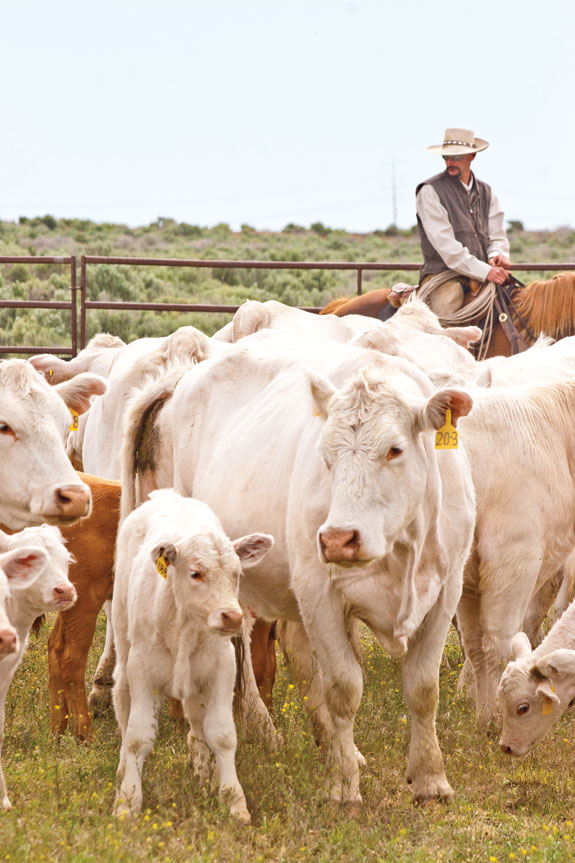It is commonly thought that certain probiotics and direct-fed microbials (DFMs) can be used as “natural” alternatives to antibiotics in cattle. While it is true that certain probiotics and DFMs can impact animal health, their use shouldn’t exclude or replace antibiotics, as there are several instances where synergies between antibiotics and probiotics exist, and probiotics can be used in conjunction with antibiotics in a cattle health management program.

The use of antibiotics in food animal production has been a hot- button issue for many years, and often those who seem to speak out the most on the subject are people who have no real experience in food animal production.
Most of us who work every day in this sector recognize the tremendous value of antibiotics as a tool for helping ensure the efficient use of resources and for improving the welfare of the animals we rely on to provide our livelihood.
There are certain unavoidable events in the life of a beef calf, such as weaning, co-mingling, transport and acclimation to a new environment, which can induce stress and expose the calf to pathogenic bacteria to which the animal’s immune system has not been acclimated.
Because of this, antibiotics are often used in high-stress weaning and receiving calves to help them deal with health challenges related to their naive immune systems and the immunosuppressive effects of these stresses.
Antibiotics can be used to metaphylactically treat (also known as mass-treatment) the entire group of calves through injection during initial processing or by using feed-grade antibiotics in a supplement or total mixed ration.
When antibiotics are used in the calf, the main consideration in terms of bacteria populations within the animal is killing the pathogenic bacteria of interest.
One effect of antibiotics that is often overlooked is the effect they have on the entire microbiome of the animal, including the beneficial microbes in the GI tract.
Microbiome is a relatively new term and is defined as the full collection of microbial genes within an organism, and is a representation of the entire microbial population within an animal.
We are just beginning to understand the importance of the microbial communities within animals for their overall health and well-being, but looking at the numbers, it appears this will be one of the next frontiers in medical advancement.
For instance, it has been estimated that an adult human carrier possesses 10 times more bacterial cells than human cells. In a beef calf with a fully functioning rumen, that ratio is presumably much greater.
The antibiotics we have on the market are extremely effective in dealing with many of the disease-causing bacteria we encounter in beef cattle production, but they may also have impacts on populations of beneficial bacteria in the gut.
This concept has been studied using other animal models, and the results have shown there is often an overall change in the gut microbial populations following antibiotic administration.
These changes are often thought to be the cause of certain afflictions such as antibiotic-associated diarrhea in humans, and one probiotic yeast strain often used to treat this condition in humans is Saccharomyces cerevisiae subspecies boulardii.
Increases in beneficial lactic-acid producing bacteria in the intestine have been observed in monogastric animals following administration of S. boulardii.
The yeast strain also produces several proteins that neutralize certain pathogenic bacterial toxins that can give those bacteria a competitive advantage in the intestine.
Another possible strategy for positively affecting the gut microflora following antibiotic administration would be to feed a Lactobacillus acidophilus bacterial strain that has the ability to colonize in the lower intestine.
These bacteria could be fed either alone or in combination with S. boulardii.
One thing to consider when feeding bacterial DFMs is that many bacterial DFMs are not compatible with many antibiotics, and they may be susceptible to the antibiotic given.
Consequently, they may not be as effective in high-stress calves who have recently received an antibiotic.
Antibiotics generally have no impact on yeast, so a yeast DFM may be more appropriate in high-stress calves, provided the strain used has been shown to be efficacious in those animals.
In a study conducted at Texas Tech University, high-stress receiving calves were all given a metaphylactic antibiotic treatment during initial processing and divided into treatment groups consisting of a control group that was not given any probiotic and a treatment group that was given S. boulardii CNCM-1079 for 35 days.
In that trial, the percentage of cattle treated once or more for bovine respiratory disease (BRD) was greater for the control group (P = 0.04) than for calves fed S. boulardii CNCM-1079 (24.0 vs. 13.8 percent, respectively).
One word of caution for using any probiotic or DFM in a calf health program is that there are several products on the market that haven’t been evaluated in a controlled research setting.
Vast differences exist in yeast and bacterial strains, even within the same species of yeast and bacteria.
To ensure a return on investment is realized for the product, it is strongly recommended the strains and doses of any probiotic or DFM used are verified through independent research trials conducted using applicable animal models. ![]()
References available upon request.
Mark Corrigan is Beef Technical Services Manager and Dan Rosener, DVM, is Monogastric Technical Specialist for Lallemand Animal Nutrition.
PHOTO
New events in a calf’s life induce stress and expose the calf to pathogenic bacteria. Photo by Julie Vasquez.

Mark Corrigan
Lallemand Animal Nutrition
mcorrigan@lallemand.com








